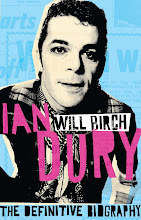Ian at Kara Lodge (photo courtesy of Jemima Dury)
The summer of 2013 sees the first major exhibition of the
paintings and artworks of Ian Dury.
The exhibition ‘Ian Dury: More Than Fair - paintings, drawingsand artworks 1961-1972’ is being staged at the Royal College of Art,
Kensington Gore, London SW7 2EU from 22 July to 1 September (Closed Mondays). Free
Admission.
The show has been put together by Ian’s daughter Jemima Dury, ‘former confederate’ Kosmo Vinyl, and one time Stiff Records art director
Julian Balme. More than 30 pieces will be on display, most of them coming from
the Dury family archive, with some pieces loaned by Ian’s friends, and
collectors.
The Royal College is an apposite venue for such a
celebration; Ian gradated there on 8 July 1966 with a diploma as an Associate
of the Royal College of Art. He went on to teach art at various schools and
colleges before forming his band Kilburn and the High Roads in 1971.
Lee Marvin
Ian: “When I was a painter I got good enough to know my limitations. To exactly place myself, and ambition is one of the driving forces of anyone’s creative output and the thought that you’re gonna be the best. You want to rank with your heroes like Renoir. There’s a room at Kenwood with a Rembrandt and a Vermeer and a Frans Hals. Once you’ve done twelve years, which I had, you get to point where you know that however hard you try, fifteen hours a day, you reach a point where you realise you ain’t necessarily gonna be good enough to please yourself. Good enough to spend that time agonising over it. Lucien Freud is always grafting, it’s pure frustration. If you’re prepared to put up with that life, you’ve got to believe in yourself to a very huge extent and I’d sooner fall asleep with a book.”
Princess Rockeberty
Ian: “A lot of
us got into The Royal College Of Art.
They called us the Walthamstow Cockneys. A load of us got in - 14 into
the painting school, let alone the dress design department. There was a mass exodus every year into The
Royal College for a further three years of jollification. Peter Blake was
teaching there, we're good mates. The
kind of work a few of us were into related to being able to enjoy things that
were popular rather than going down the bleeding library all the time.”
Hey, Hey Mobile
Ian: “I met Betty,
my late first wife, at the Royal College of Art. She was at Newport College of
Art. Her dad went to the Royal College of Art in the thirties. Getting into the
RCA was the only thing I've aspired to in my life. I spent two years trying to
get in. It’s the only achievement I've ever felt, a bit like going to the
university of your choice. I’m really pleased I went there, I’m proud of it. I
wouldn't have been able to learn about how to live as a person doing what they
want to do if I hadn't gone there, allowing your determination and output to
control the way things go - my nine and my five.”
At the time of writing, a Kickstarter campaign has been launched to raise the £10,000 needed to ensure that the show goes ahead. Supporters have been asked to donate here:
http://www.kickstarter.com/projects/1996276438/ian-dury-more-than-fair-art-exhibition/
See you there!
Follow Will Birch on Twitter
Will Birch website
At the time of writing, a Kickstarter campaign has been launched to raise the £10,000 needed to ensure that the show goes ahead. Supporters have been asked to donate here:
http://www.kickstarter.com/projects/1996276438/ian-dury-more-than-fair-art-exhibition/
See you there!
Follow Will Birch on Twitter
Will Birch website


















